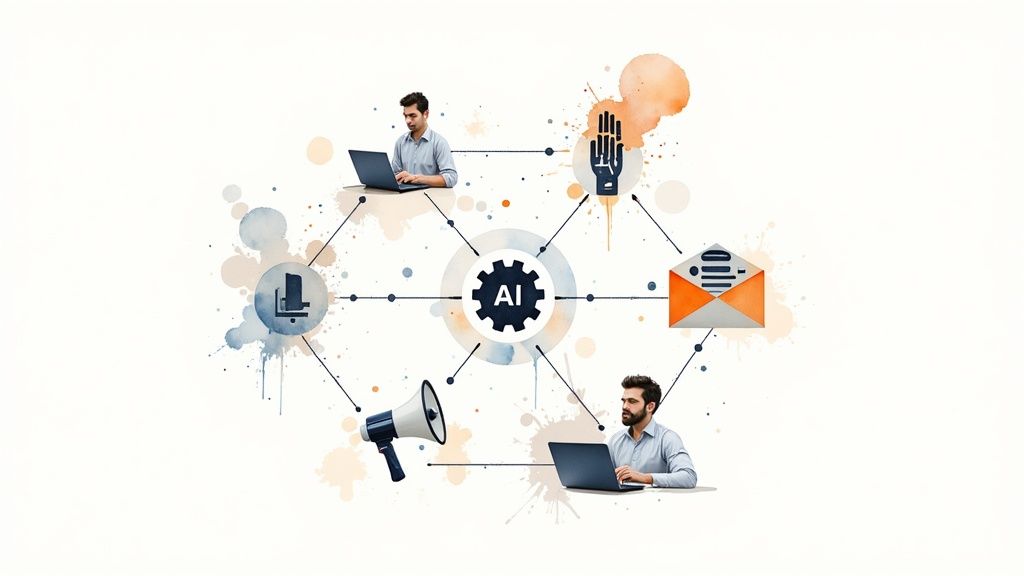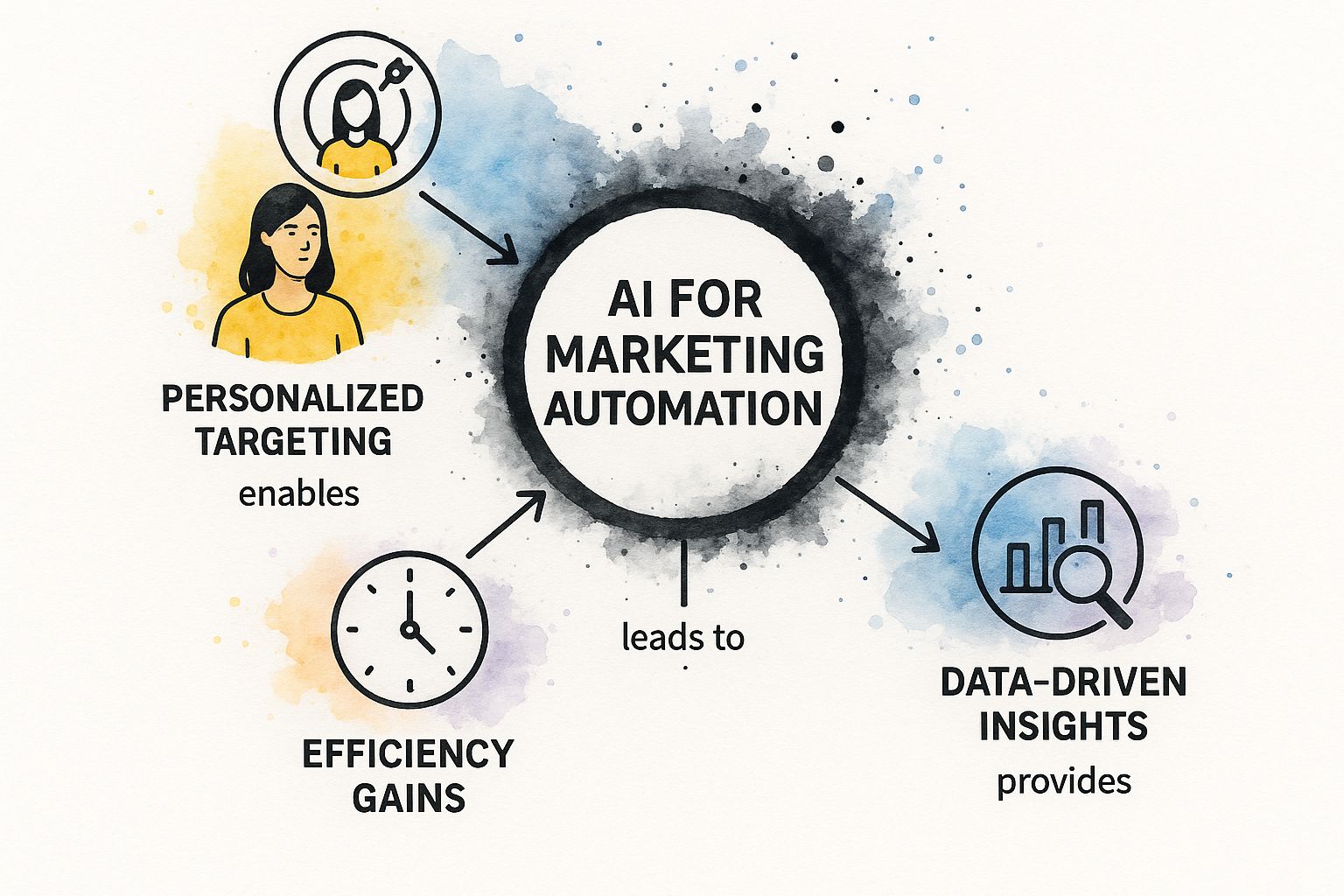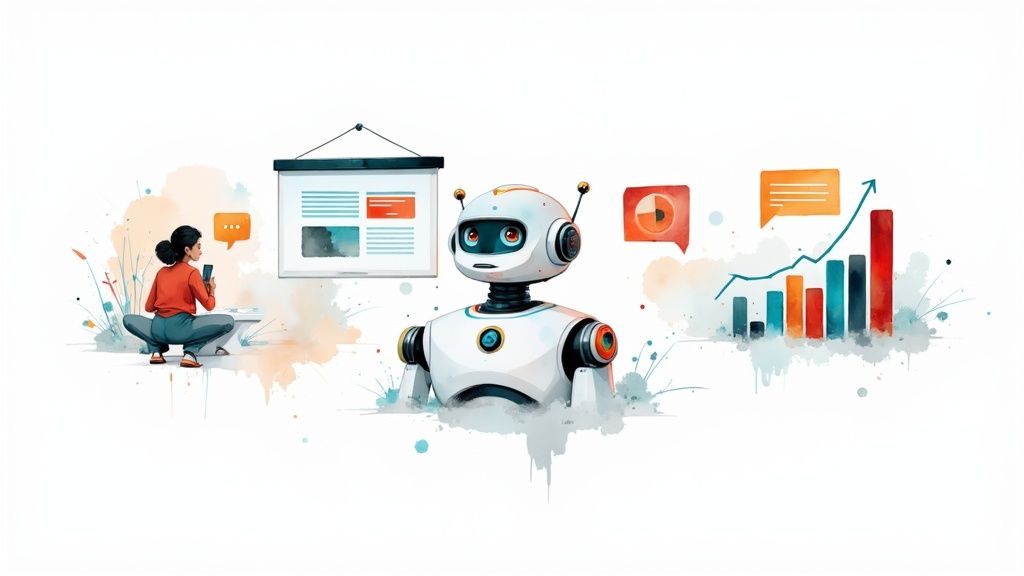AI in marketing automation is a total game-changer for how you connect with customers. Forget the old, rigid rules. We're talking about using real intelligence to figure out what people will do next and give them a truly personal experience, right in the moment. This is about moving away from set-and-forget campaigns and into conversations that adapt and learn.
Moving From Automation To True Intelligence

Think of your current marketing automation platform like a basic sprinkler system. You set it to run on a fixed schedule. It's efficient, sure, but it has zero awareness of what's actually happening. That sprinkler will happily water your lawn during a downpour just because the calendar says it's time.
That’s exactly how traditional, rule-based automation works. It’s all about simple "if this, then that" logic. If someone downloads an ebook, then they get a specific follow-up email. It’s a decent start, but it’s completely reactive. It also treats every single customer who takes the same action in the exact same way, missing all the important context about who they are and what they really want.
The Leap to Predictive Engagement
Now, let's upgrade that sprinkler. Imagine a smart irrigation system instead. This one checks weather forecasts, reads the moisture in the soil, and even looks at the health of the plants to water exactly when and where it's needed. It doesn't just follow a schedule; it actually anticipates what the garden needs and adapts on the fly. That's the leap you make when you bring in AI for marketing automation.
Instead of just reacting to what a customer did, AI-powered systems start to predict what they’ll do. They crunch thousands of data points—from browsing history and past purchases to email clicks and even social media chatter—to get a real sense of what a customer’s next move might be. This completely flips your strategy from just running pre-built workflows to creating customer journeys that are genuinely dynamic.
An AI system doesn't just see that a user clicked on a product page. It understands the entire journey that got them there, compares it to millions of others, and predicts their chances of buying. This lets you step in with a personalized offer before they even think about leaving their cart.
From Static Rules to Dynamic Relationships
This whole shift is way more than just a tech upgrade. It's a fundamental change in how you build relationships with your customers. AI lets you blow past broad, clunky segments and get into true one-to-one personalization, but for your entire audience. The results speak for themselves and hit your bottom line directly:
- Anticipatory Marketing: AI can spot customers who are about to churn and kick off a retention campaign before you lose them. It can also score leads with such incredible accuracy that your sales team only spends time on the deals most likely to close.
- True Personalization: This is where you get dynamic content that literally changes for every single person who sees it. Every message, offer, and product recommendation feels like it was made just for them, because it was.
- Optimized Resource Allocation: By predicting how campaigns will perform, AI helps you put your budget where it will have the biggest impact. No more guessing which channels will deliver the best return on investment.
At the end of the day, using AI for marketing automation isn't about throwing out your strategy. It’s about making it smarter. It’s the next logical step toward creating marketing that feels less like a megaphone and more like a genuinely helpful, one-on-one conversation that gets real results.
How AI Redefines Marketing Automation
To really get what makes AI-powered marketing automation different, we need to look under the hood. This isn't some black-box magic; it’s all about smart, sophisticated processes that learn and adapt on their own. The two main engines driving this shift are machine learning and predictive analytics. Together, they turn your marketing platform from a simple task-doer into a proactive growth machine.
Think about hiring a new sales intern. On day one, you hand them a script and a list of rules to follow. That's your traditional, rigid automation.
Now, imagine that same intern a few months later, after hundreds of customer conversations. They start spotting patterns, anticipating questions, and knowing just what to say to each new person they talk to. That’s machine learning in action.
The Power of Predictive Learning
Machine learning algorithms are built to find patterns in massive amounts of data without you having to spell out every single rule. Instead of creating a workflow like, "If a user visits the pricing page three times, send them a discount," the AI sifts through thousands of data points on its own. It's looking at everything—browsing history, email engagement, past purchases, time on page, you name it.
From all that data, it builds a predictive model. The system learns what behaviors signal a customer is ready to buy, which actions suggest they might be losing interest, and what kind of content will click with a specific person. It’s a constant cycle of learning and tweaking that gets sharper with every single interaction.
This shift takes your strategy from building static, clunky segments to creating dynamic, one-to-one personalization at a scale that would be impossible for any human team. It’s all about crafting a unique, optimized journey for every customer, based on what they're doing right now and what the AI predicts they'll do next.
From Data Points to Customer Journeys
This data-first approach lets AI completely reshape your automation strategy. It's no longer just about sending the right email at the right time; it's about engineering the perfect experience across every single touchpoint.
Here's a quick look at how AI turns raw data into intelligent action: * Hyper-Personalization: Forget broad buckets like "new leads." AI creates micro-segments, often down to a single person. It can dynamically change website content, recommend products, and tweak email copy to match each user's profile and real-time behavior. * Predictive Lead Scoring: AI looks at the attributes and actions of your best customers to build a model of your ideal buyer. It then scores new leads based on how well they fit that profile, making sure your sales team only chases the hottest opportunities. * Optimal Send Times and Channels: The system figures out when each individual is most likely to open an email or click on a notification. It can then automatically schedule messages for the exact moment they're most likely to be seen and acted on.
This infographic breaks down the core benefits you get when you layer AI onto your marketing automation.

As you can see, these capabilities lead directly to smarter targeting, better efficiency, and deeper insights that fuel constant improvement. For more on this, you can check out the growth strategy guides on our blog.
The difference between old-school automation and what's possible with AI is pretty stark.
Traditional Automation vs AI-Powered Automation
| Feature | Traditional Marketing Automation | AI for Marketing Automation |
|---|---|---|
| Logic | Rule-based (If/Then statements) | Data-driven and adaptive |
| Personalization | Segment-based (e.g., "all new leads") | Hyper-personalized (1-to-1) |
| Lead Scoring | Manual point assignment | Predictive and dynamic |
| Optimization | Requires manual A/B testing | Self-optimizing in real-time |
| Content | Static templates | Dynamic content generation |
| Insights | Basic performance reports | Predictive analytics and forecasting |
Ultimately, traditional automation follows the rules you give it. AI-powered automation learns from the data to write its own, much smarter rules.
The demand for these smarter tools is exploding. The global market for marketing automation is on track to hit $15.62 billion by 2030, driven by the 91% of decision-makers who say automation requests are on the rise. AI is at the heart of this, with 77% of marketers already using it for content creation to scale their personalized campaigns.
Putting AI to Work in Your Marketing Funnel
 Okay, understanding the theory behind AI for marketing automation is one thing. Seeing it in action is where the lightbulb really goes off. AI isn’t some abstract process humming in the background; it's an active player that can sharpen every single stage of your marketing funnel.
Okay, understanding the theory behind AI for marketing automation is one thing. Seeing it in action is where the lightbulb really goes off. AI isn’t some abstract process humming in the background; it's an active player that can sharpen every single stage of your marketing funnel.
From the first handshake with a total stranger to delighting your most loyal customers, AI adds a layer of intelligence that gets real, tangible results. Let’s move past the concepts and look at exactly how this works at each step of the journey.
Attracting Attention with Intelligent Advertising
The top of the funnel is all about getting in front of the right eyeballs. In the past, this meant a whole lot of guesswork and constantly fiddling with budgets. With AI, that whole process gets razor-sharp.
Take programmatic ad buying, for example. This uses AI algorithms to automate buying ad space in real-time. Instead of you picking websites and times, the AI crunches millions of data points to bid on the placements most likely to hit your ideal customer, right when they’re ready to listen.
This means your ad spend gets optimized on the fly, stretching every dollar to maximize reach without wasting a cent on the wrong audience. It’s a data-first approach that brings in higher-quality traffic from the word go.
Nurturing Leads Through Smart Consideration
Once you’ve got someone’s attention, the real work begins. The consideration phase is where AI truly shines, turning generic lead nurturing into a personalized conversation that guides someone toward a decision.
Predictive lead scoring is a total game-changer here. Forget assigning points for simple stuff like opening an email. AI models analyze thousands of behaviors—subtle patterns your team would never spot—to calculate a lead's actual likelihood of converting. This lets your sales team focus their energy only on the people who are genuinely ready to talk.
AI doesn't just score leads; it creates a dynamic feedback loop. As leads convert or go cold, the model learns and refines its predictions, becoming progressively more accurate over time. This continuous improvement means your sales team's efficiency increases month after month.
AI-powered email campaigns can even change their content as they go.
- Dynamic Content Blocks: An e-commerce store can use AI to automatically slot in products a user just looked at or items that go perfectly with something they already bought.
- Behavior-Triggered Workflows: A SaaS company could notice a user keeps visiting the "integrations" page and automatically send them a case study about a similar company that crushed it using that exact feature.
Every single touchpoint is shaped by that individual's journey, making your communication feel less like marketing and more like helpful advice.
Driving Conversions with Personal Guidance
At the finish line—the conversion—AI acts like a smart assistant, smoothing out any bumps and nudging users toward the purchase. AI-powered chatbots are the perfect example of this.
But we're not talking about those clunky bots from a few years ago. Modern chatbots can tap into customer data to offer personalized product recommendations, walk users through the checkout process, and even offer a timely discount to stop someone from abandoning their cart.
A customer asking, "Do you have this in blue?" gets an instant reply with a direct link to buy it. The entire process is seamless. Plus, these AI assistants are on the job 24/7, meaning you never lose a sale just because it's after hours.
Fostering Loyalty and Retention
Getting the customer is only half the battle. Keeping them is where long-term success is built, and AI gives you some powerful tools for building loyalty and stopping churn.
Churn prediction models are a huge asset here. These AI systems analyze customer behavior, support ticket history, and how they use your product to flag customers who are at risk of leaving. This gives your team a critical heads-up, letting you proactively reach out with a special offer or helpful content to win them back before they’re gone.
AI can also power personalized follow-ups after a purchase, maybe recommending a complementary product or offering tips on getting the most out of what they just bought. It’s that kind of thoughtful, relevant engagement that makes customers feel seen and valued, turning a one-time buyer into a true fan of your brand.
Your Guide to Implementing AI Marketing Tools

Bringing new technology into the mix can feel like a massive project, but weaving AI for marketing automation into your strategy is more manageable than you might think. The key is to see it not as a complete teardown, but as a smart, step-by-step upgrade to what you’re already doing.
Success here doesn’t start with buying flashy software. It starts with a solid foundation: a deep understanding of your current marketing world and a crystal-clear vision of what you’re trying to accomplish. This approach ensures you pick the right tools and actually see a real return on your investment.
Audit Your Current Data and Tech Stack
Before you can build anything new, you need to know what you’re working with. Kick things off by taking a serious inventory of your marketing tech and—more importantly—your data. AI is only as good as the data it’s fed, so this is your non-negotiable first step.
Get real with yourself and ask a few tough questions:
- Data Quality: Is our customer data accurate and complete, or is it a mess of outdated info?
- Data Accessibility: Is our data trapped in different systems that don’t talk to each other?
- Tech Compatibility: Can a new AI tool actually plug into our CRM, email platform, and analytics software without causing a meltdown?
This audit will quickly show you where the cracks are. It'll highlight where AI can make the biggest difference—maybe it’s in qualifying leads, personalizing customer experiences, or automating content—and what cleanup work you need to tackle first.
Set Specific and Measurable Goals
With a clear picture of your starting point, it's time to set some real, measurable goals. Vague ambitions like "improve marketing" are useless here. You need concrete targets that a machine can work towards and that you can use to prove this was all worth it.
Good goals are sharp and focused on outcomes. Think along these lines:
- Cut shopping cart abandonment by 15% next quarter using an AI-powered chatbot.
- Boost the conversion rate of marketing qualified leads (MQLs) to sales qualified leads (SQLs) by 20% with a predictive scoring model.
- Lift email open rates by 10% by letting an AI tool figure out the perfect send time.
These kinds of goals give your project a clear direction and provide the hard numbers you’ll need to justify the investment down the road.
Select the Right AI Marketing Tools
Now you’re finally ready to shop for tools. The market is exploding, with the AI in marketing industry expected to jump from $47.32 billion in 2025 to over $107.5 billion by 2028. That explosive growth means you have tons of options, but it also means you have to choose carefully. For a deeper look at your options, you can check out some of the top ecommerce AI tools to see what’s out there.
Zero in on solutions that directly solve the problems and hit the goals you’ve already defined. Always prioritize tools that play nice with your current tech and can grow with you. For example, if your goal is to get more leads to convert, an AI tool that optimizes your https://rebelgrowth.com/landing-pages could be a game-changer.
Key Takeaway: Don't get distracted by the latest shiny object. Pick the tool that solves your specific business challenge. The best AI tool is the one that fits into your workflow and starts delivering results fast, without forcing your team to start from scratch.
Launch a Pilot Project and Scale
Whatever you do, don't attempt a massive, company-wide rollout from day one. That’s a recipe for disaster. Instead, start small with a focused pilot project to test the waters and prove the tool's value in a controlled setting. Pick a single campaign or a specific customer group and run the AI solution side-by-side with your old methods.
This lets you iron out any wrinkles, get your team comfortable, and gather the data to build a rock-solid case for a bigger investment. Once you have proof that it's working—like better engagement or a lower cost to acquire a customer—you can scale the solution across the rest of your marketing with confidence.
Measuring the Real ROI of Your AI Investment
Investing in AI for marketing automation is exciting, but let’s be honest: the real test is proving it actually makes a difference to your bottom line. How do you show stakeholders that your new intelligent tools are more than just fancy tech?
It all starts by moving beyond simple vanity metrics. You have to connect every AI initiative to tangible business outcomes that everyone understands: money saved and money earned.
Key Metrics That Prove AI's Value
Forget surface-level numbers for a minute. The real proof of your AI investment lies in the metrics that directly reflect growth and efficiency.
- Customer Lifetime Value (CLV): AI-powered personalization and churn prediction are designed to keep customers happy and coming back. When you see a steady increase in CLV, it's a powerful sign that your AI strategies are building stronger, more profitable relationships.
- Customer Acquisition Cost (CAC): By optimizing ad spend with predictive analytics and scoring leads more accurately, AI helps you attract better-fit customers for less money. A falling CAC means your marketing dollars are working harder, bringing in new business more efficiently.
- Marketing Team Efficiency: How much time is your team actually saving? AI automates the grunt work—like data analysis, report generation, and content scheduling—freeing up your marketers to focus on big-picture strategy and creative campaigns. Tracking hours saved translates directly into real productivity gains.
These metrics tell a clear, financial story about your AI's impact. To really nail this down, it helps to understand how to measure marketing ROI, which gives you a solid framework for tying your efforts to results.
Calculating Your Return on Investment
Let’s walk through a practical scenario to see how this all comes together. Imagine your marketing team invests in an AI tool that automates lead scoring and personalized email nurturing.
The Goal: To boost the conversion rate of Marketing Qualified Leads (MQLs) into paying customers and stop the sales team from wasting time on dead-end prospects.
To figure out the ROI, you'll need to track a few key data points before and after you flip the switch on the new AI tool.
Before AI Implementation: * MQLs Generated: 1,000 per month * Conversion Rate (MQL to Customer): 3% (30 new customers) * Average Revenue Per Customer: $2,000 * Total Monthly Revenue from MQLs: $60,000
After AI Implementation (3 Months Later): * MQLs Generated: 1,000 per month * Conversion Rate (MQL to Customer): 5% (50 new customers) * Average Revenue Per Customer: $2,000 * Total Monthly Revenue from MQLs: $100,000
Just like that, the AI-driven predictive scoring and personalization led to a $40,000 bump in monthly revenue.
If the AI tool costs $5,000 per month, your net gain is $35,000. That's a clear and powerful ROI that proves the financial muscle of intelligent automation. Many of the fastest-growing companies use this exact logic to justify their tech stack.
By focusing on these core business metrics, you can confidently prove that your investment in AI for marketing automation isn't just another expense—it's a strategic engine for growth and profitability.
The Future of AI in Marketing and How to Prepare
The world of AI for marketing automation is moving at breakneck speed. What feels like a shiny new toy today will be standard practice tomorrow. If you want to stay ahead of the curve, you need to understand where this is all going and, more importantly, get your team ready for the shift.
The next wave is going to push way beyond just automating simple tasks. We're talking about creating truly individual customer experiences on a massive scale. Think of it like this: we're moving from a personalized email to a completely personalized, AI-guided journey for every single customer, from the first ad they see to their tenth purchase and beyond.
Key Trends Shaping the Future
A few big trends are already defining this next chapter. The first is hyper-personalization. This is where AI algorithms craft marketing messages and experiences so unique they feel like a one-on-one conversation. It's about dynamically changing everything from website layouts to product recommendations based on what a user is doing in real-time.
Another huge shift is the explosion of generative AI in creating campaigns. We're already seeing tools that can draft email copy, design ad visuals, and even spit out an entire marketing strategy outline. This lets teams brainstorm and launch campaigns faster than ever, but it also means human oversight and strategic thinking are more valuable than ever.
Finally, the ethical questions are moving from the back room to front and center.
- Data Privacy: As AI models get hungrier for data, both consumers and regulators are demanding more transparency about how personal information gets collected and used.
- Algorithmic Transparency: Businesses will need to be ready to explain how their AI makes decisions. This is crucial for avoiding bias and ensuring everything is fair and above board.
Future-Proofing Your Marketing Team
Getting ready for this future isn’t about just buying the latest software. It's about building the right skills and mindset within your team. The focus has to shift away from manual, repetitive work and toward high-level strategic thinking.
Your job won't be taken by AI, but it might be taken by someone who knows how to use AI. This simple truth highlights that the goal isn't to replace marketers but to empower them.
To get your team ready, you need to prioritize three key areas:
- Encourage Continuous Learning: The tools and techniques are going to change constantly. You need to build a culture where your team is always experimenting with new AI platforms and sharing what they learn with everyone else.
- Build Data Literacy: Marketers don't need to become data scientists, but they absolutely must understand how to read data, ask the right questions, and spot trends. This skill is what allows you to guide AI systems effectively instead of just letting them run wild.
- Prioritize Strategic Thinking: With AI handling the grunt work, the real value of your team will be their creativity, their deep brand knowledge, and their ability to plan. Freeing them from the mundane gives them the space to focus on the big-picture ideas that actually drive growth.
Common Questions About AI in Marketing Automation
Even with all this potential, wading into the world of AI for marketing automation can feel a little daunting. You’ve probably got some questions, and maybe a few concerns. That’s perfectly normal. Getting straight answers is the best way to move forward with confidence, so let's clear up some of the most common things marketers ask.
The big one always comes up first: will AI replace marketers? The short answer is no. A better way to think about it is that AI is the ultimate assistant. It’s here to handle the repetitive, data-heavy lifting, which frees up your team to lean into what people are amazing at—strategy, creative thinking, and forging real connections with your audience.
Your job won't be taken by AI. It will be taken by a person who knows how to use AI. This hits the nail on the head. The whole point is to make your skills even more powerful, not to make them obsolete.
Getting Started and Avoiding Pitfalls
Another frequent worry is all about data. A lot of marketers think they don’t have “enough” of it to get started. But the truth is, you can probably start with what you already have sitting in your CRM and analytics tools. The trick is to begin with a specific goal in mind and choose an AI tool that can work with your existing setup, helping you build richer data sets as you go.
Finally, what are the biggest mistakes people make when they dive in? Two major tripwires catch teams out all the time:
- Unclear Goals: Jumping into AI without a clear, measurable objective is like setting sail without a map. You need to know exactly what you’re trying to do, whether that’s cutting down on churn or boosting the quality of your leads.
- Poor Data Quality: Your AI is only as smart as the data it learns from. If your information is a mess, your results will be, too. It’s always worth doing a quick data audit and cleanup before you kick things off.
The proof is in the numbers. Marketers who get this right see massive gains. A recent study found that 93% of marketers using AI are creating content faster, and 81% are uncovering insights from their data more quickly. On top of that, 90% are using AI to make faster decisions, proving its power to speed up the whole strategic process. You can dig into more marketing statistics about AI to see just how big the impact is. By tackling these common questions head-on and steering clear of a few simple mistakes, you'll be in a great position to make intelligent automation work for you.
Ready to transform your marketing with the power of AI? rebelgrowth provides a complete suite of tools, from AI-generated content and social media scheduling to an intelligent marketing agent that supercharges your strategy. Start driving real growth today by visiting https://rebelgrowth.com.
